Written by Terry Smith
Our site is reader supported so when you click a link to Amazon we may earn an affiliate commission.
UK’s best paint sprayers TESTED for walls, ceilings, kitchen cabinets, and furniture on a budget!
This article was last updated on April 23rd, 2022 at 6:17 am
I just recently tested the best fence paint and shed paint so this follows on nicely from the best fence sprayers test. It got me thinking could we repurpose these sprayers around the home? A quick bit of testing showed me absolutely yes and in fact as I quickly learn’t some are branded as paint sprayers! Be it walls, ceilings, cabinets, or old furniture. The tests came out reasonably well – I was a bit critical of the overspray but had to remind myself we are only talking about budget paint sprayers. In fact, they were so effective considering the low price, I decided to buy another Wagner W100 (rather than the fence and decking sprayer version) that is specifically designed for paint spraying on a budget and test that too – on kitchen cabinets. Wagner have some superb mid range stuff but I’ve left most out due to the fact the budget sprayers do so well already!
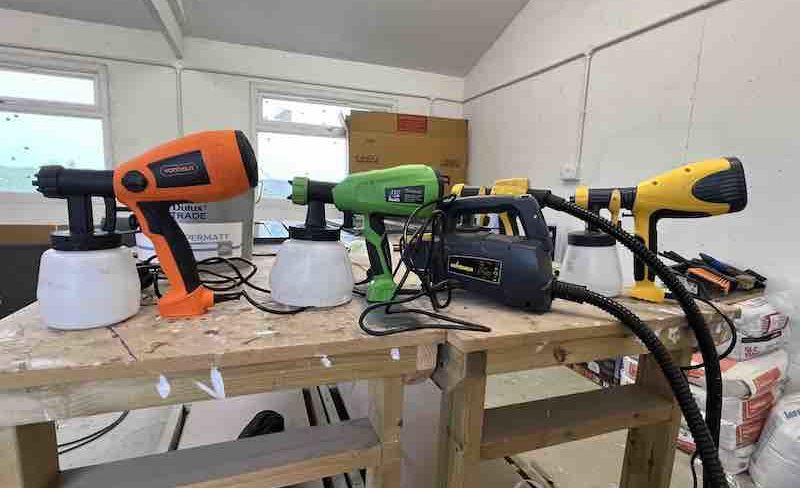
I have to say, whilst in a professional capacity I use paint sprayers that cost thousands of pounds with huge pressure and ultra fine spray that are so powerful you could even spray garage floor paint if you wanted, I compare them against these budget sprayers for the home and kitchen, and what they can produce. The results are pretty unexpected I have to tell you with some real stand out equipment on offer in this article for less than a family dinner out! Whilst yes, the kitchen cabinets I split test come out better on my workshop sprayer, you can replicate most of the effect with the best paint sprayers on a budget at home too! Especially if using water based paint as my kitchen cabinet paint sprayer tests will show you. You also might prefer to look at my wall and ceiling paint sprayer test too. So from here’s there’s three choices, fast forward to my conclusions below and read the best paint sprayer, or take a look at the paint sprayer tests to see what we can actually get from them. Finally, if you would like to learn more, please feel free to take a look at my paint sprayer buyer guide.
Best paint sprayers in the UK on a budget – my top picks as a professional paint sprayer:
Best paint sprayer: Wagner W 100 Electric Paint Sprayer [Personally tested and proven]
Most powerful paint sprayer on a budget: Wagner Fence & Decking Paint Sprayer [Personally tested and proven]
Best paint sprayer for kitchen cabinets on a budget: Ginour paint sprayer [Personally tested on kitchen cabinets and proven]
Best paint sprayer for ceilings and walls: [Personally tested on wall and ceilings and proven]
Alternative pick: Vonhaus paint sprayer – slow but leaves a nice finish on walls and cabinets/wood [Personally tested and proven]
Some decent alternatives worth a look:
NoCry 1200ml/min Electric Paint Sprayer
Tacklife Paint Sprayer, SGP15AC Electric Paint Spray Gun
Terratek Paint Sprayer, 550W DIY Electric Spray Gun
Paint Sprayer,Meterk Electric Spray Gun
Paint sprayers buyers guide
Are your walls, ceilings, fencing, or kitchen cabinets starting to look a bit weathered or tired? Well, it’s probably time you gave them a fresh coating of paint. We all know how time consuming and how much effort it can be to attack a large area armed with only a roller, or even worse- only a brush!
A lot of modern paint sprayers can seem very similar at first glance, and even after a closer look. However there are a few things that can separate the wheat from the chaff, and also a few bits of information that you could do with knowing if you are serious about buying a paint sprayer for walls.
This buyer’s guide has been put together for you to provide you with knowledge you need to make the right decision on your purchase.
Size and weight are important
Before you buy a paint sprayer, take into account how large and heavy the sprayer is. Think about it, you are going to have to hold that thing in your hand for long periods of time and if it’s too heavy you are probably not going to be having a great time using it – especially on your back. I established that with the Ginour on fence panels – great tool for the money but the weight of the 1.3l pot combined with motor was just too much. It’s easy to see why the demos all end up with two hands holding the trigger 🙂 The Wagner W100 seems to balance this the best from my testing of actual paint spraying. However the Wagner fence sprayer has the turbine separate and is by far and away the most comfortable and powerful. The question is, can you accept a lower standard of finish 🤔 – to understand that comment better please take a look at my personal testing.
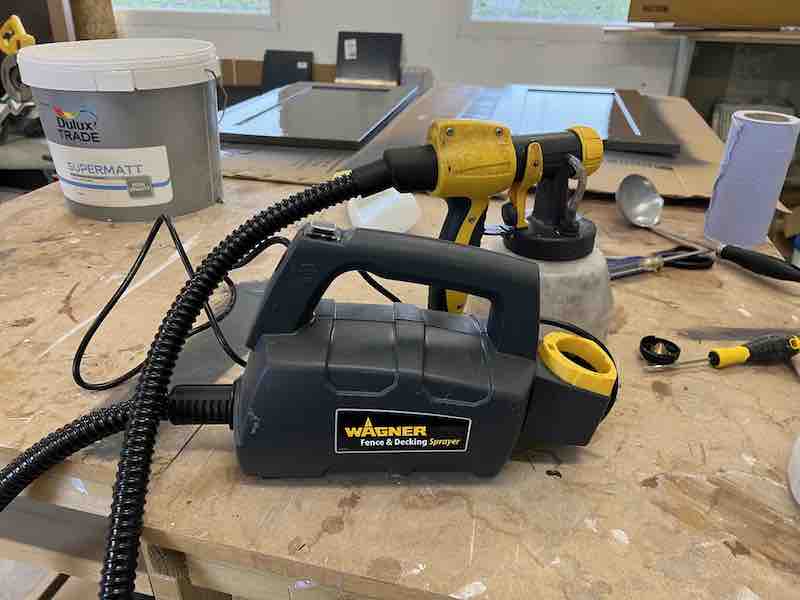
In terms of the tool itself though, a little bit of weight is a good sign that the tool is robust and made from durable materials, so there is that to consider.
Then there is the size of the paint sprayer pot, smaller models are great for getting into tighter spaces but they usually have smaller paint containers (600-800ml) like the Vonhaus and so you have to refill much more often. It’s hard to find the right balance, and that is why there are so many different models out there of various sizes and weights. Only you can decide which is best for you.
Power and maximum viscosity
With electric paint sprayers, the higher the number of watts that the electric motor is, the more raw power it has. 400 watts should be about the lowest you go with and if you are planning to do a big job, you really should be going a fair bit higher with something like 600W.
You also need to be aware of the maximum viscosity that the paint sprayer can handle as this will have a big impact on what paints and materials you can use. Viscosity is measured in DIN/sec and the higher the number before that measurement the thicker the paint that the sprayer can handle. Models with low DIN/sec require you to water down the paint a lot more beforehand whereas a model like the Wagner we reviewed above can spray ordinary paint without any mixing. However, no paint sprayer will handle the Dulux matt emulsion I show you in my paint sprayer tests and will definitely need to be thinned.
Volume of the paint container
The maximum capacity of the paint container attachment is quite important. This is because the smaller the capacity, the more time you will be spending refilling it with paint.
Average sizes are around 1000ml but be on the lookout for models with larger containers that can hold 1400ml or more as it will save you time and hassle in the long run. Here’s a look at a smaller pot vs large:
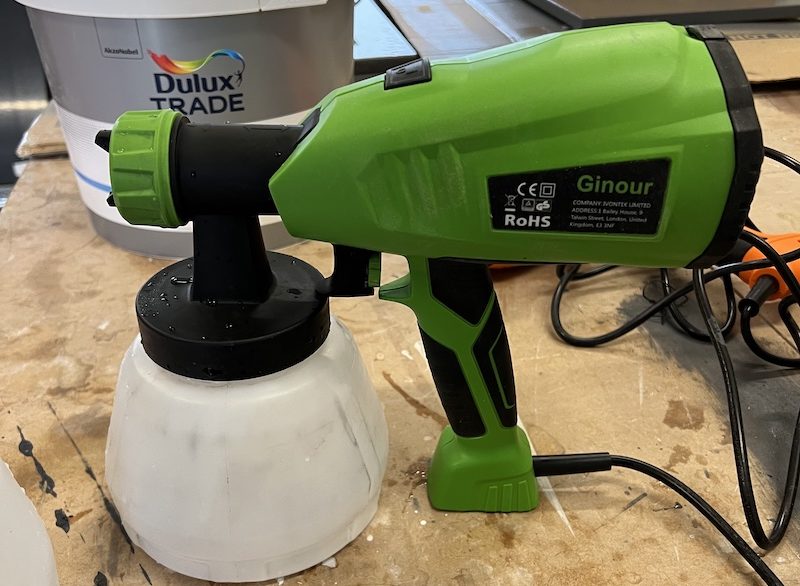
The Ginour carries 1.3l plus of paint whereas the Wagner W100 only carries 0.8 litres:
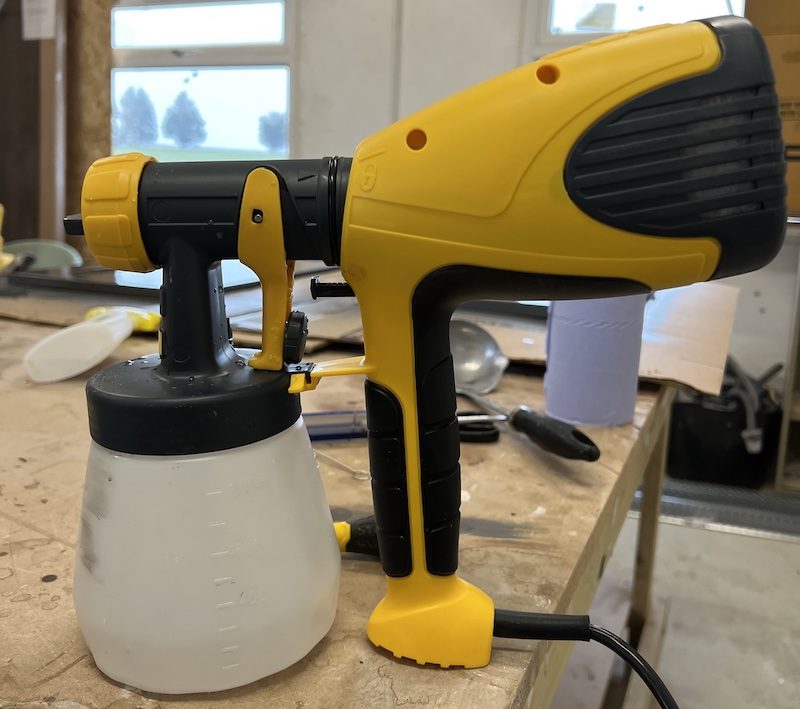
Then again, a much larger paint container will mean that the overall size of the paint sprayer will increase, so it all depends on what is more important to you personally- compactness or volume.
Customisation
Nearly all decent paint sprayers will allow you to select from 3 spray patterns by twisting the end of the nozzle, but some models go a bit farther than that. The Ginour has variable bores for a finer or thicker spray – I have to say this worked on the kitchen cabinet paint sprayer test. It is always a good thing to have multiple different sized nozzles to choose from to suit various jobs, and adjustable air flow or paint flow is a must too. Some paint sprayers even allow you to adjust the width of the spray on top of all this. Incidentally, these are amazing if you want to restore garden furniture as well.
Basically, the more control you have over the spray, the better it is for you.
Types of paint sprayers
There are three main types of paint sprayers- airless, air powered, and pneumatic. Pneumatic sprayers are the most powerful but are also quite expensive and usually used by professionals.
Airless paint sprayers are also quite powerful but it is much more difficult to use them for more refined painting jobs as they pump out paint at high pressures.
Air powered paint sprayers are better for jobs that require a bit of finesse because they produce a less powerful spray and thinner layer of paint.
Finally, if you feel these are a little pricey, you can always go back to the good old paint roller.
Paint sprayer tests – comparing home sprayers to professional setups I use daily
I decided I should take advantage of my inside knowledge with regards to paint spraying and finishes. In a professional capacity we finish kitchen cabinets down to 1600 grit sand paper. If you know what that is, you’ll know we fit out banks, coffee shops, and other high end contemporary units. So I’ve decided to finish a kitchen cabinet to the same standard we would for a customer who walks in with an old cupboard, then take it home, and compare it to what I can produce with the budget paint sprayers in this article.
After that, I take a look at the finish on walls and ceilings, using plasterboard as a guide so we can look really close up at the finish. From there, I have a go at revamping an old bit of furniture too.
Kitchen cabinet paint sprayer tests
Knowing what I know from using these as fence sprayers, I already knew the Wagner fence sprayer would have too much overspray, and I also knew the Vonhaus would be OK. So what I did was picked the knew Wagner W100 I just bought and put it against the Ginour as this has a variable nozzle size kit that should mean a finer spray 🙂 and therefore should easily beat the Wagner which just has the one larger bore nozzle:
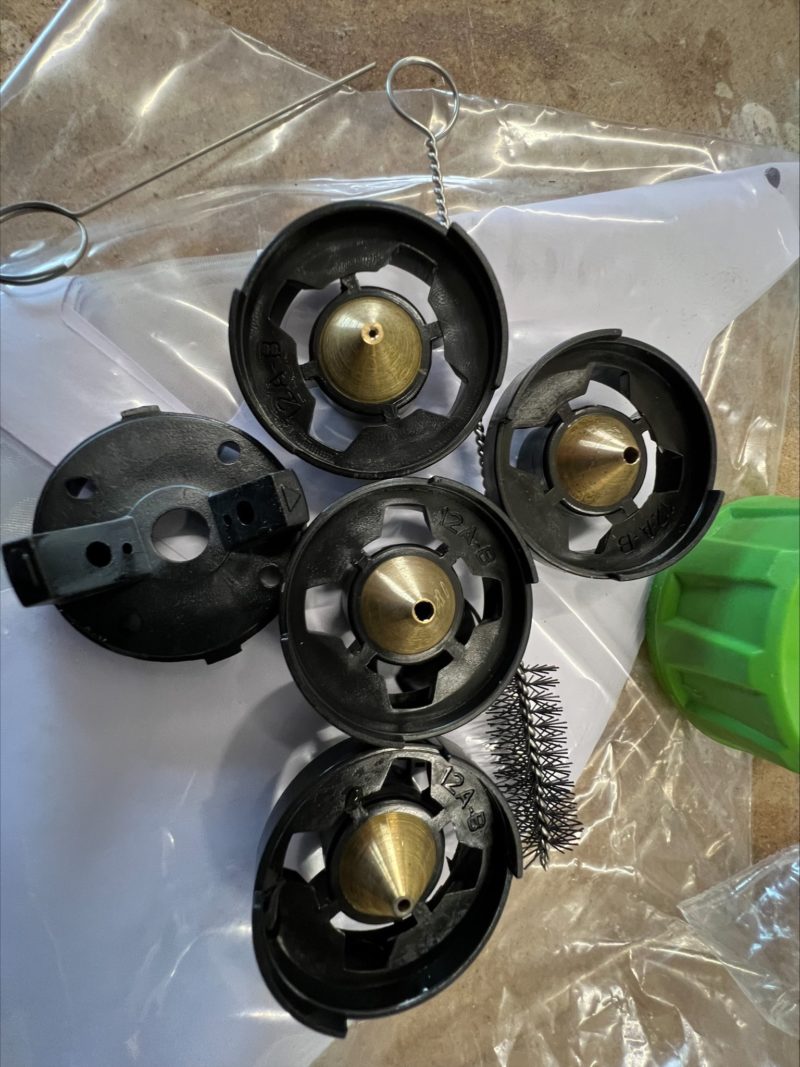
The results were not quite as expected but let’s take a look. The first thing to note is I wasn’t happy with the spluttering and overspray – this applies to both sprayers. However, as I began to use them more and more I realised the overspray was going to be a factor and water based paint will flatten off I continued the testing – my expectations were too high basically. I instantly realised as wall and ceiling sprayers they would work much better – more on that later. So here’s a look at how the Ginour came out:
Bear in mind we have a professional spray setup at the workshop though. So spraying fine atomised paint is a norm for me, I had to recalibrate my thought process – these sprayers are fifty quid!
For the Ginour the the spray was much thinner. This isn’t necessarily such a bad thing it’ll just mean more layers. Here’s a look at the first layer set first:
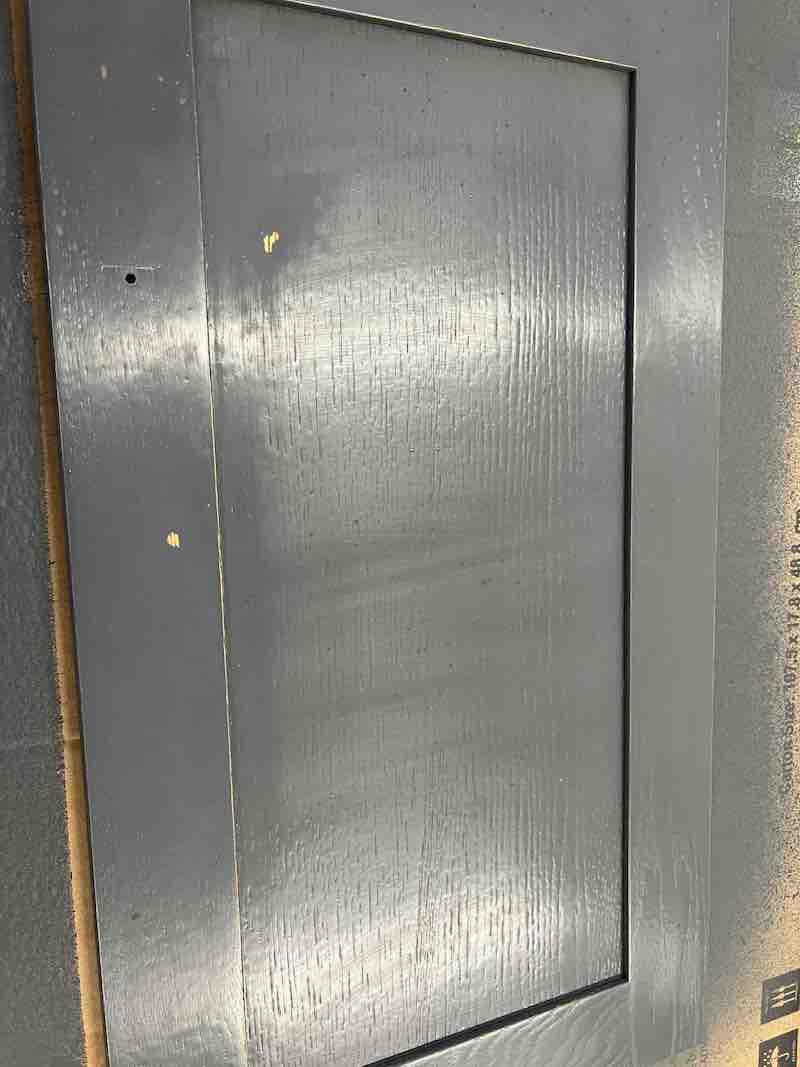
So once the second coat went on it started feeling like a pretty good finish. Here’s a look at the second coat of Ginour:
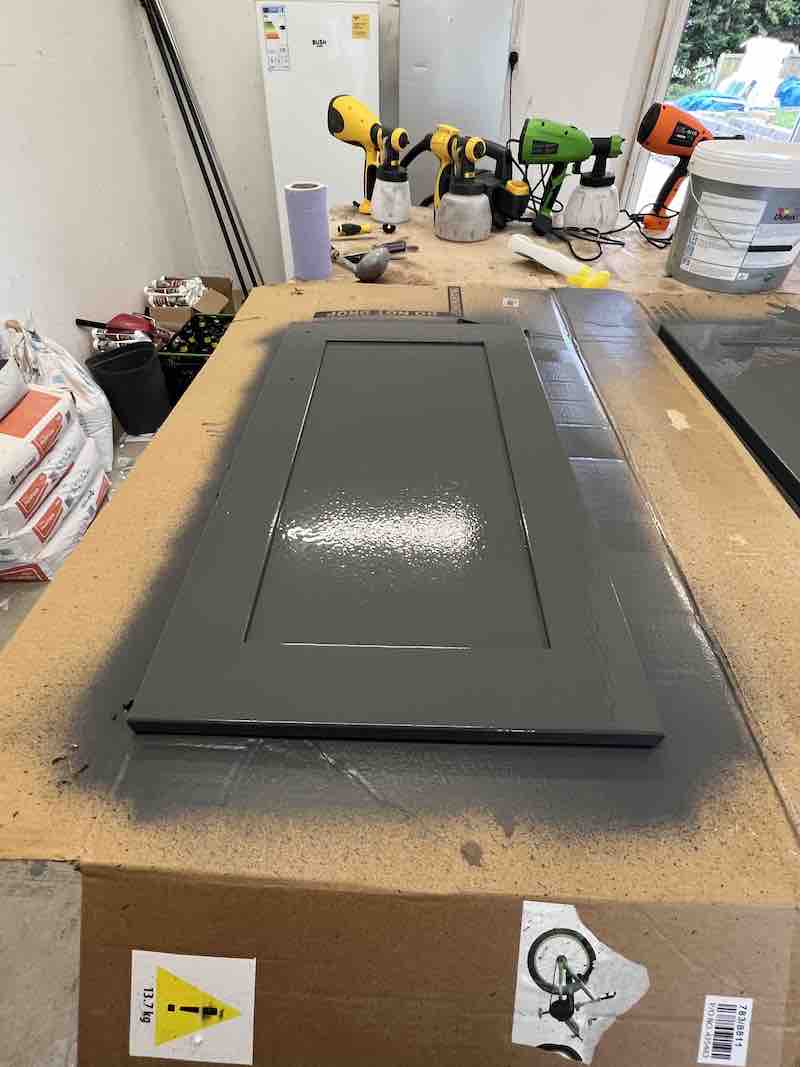
I would say the Ginour was a better bet if you want to work slowly but it did splutter a bit more, look around the cardboard and you can see loads of splotches – this is just something you’ll have to deal with when using these cheaper paint sprayers.
Here’s a look at the Ginour paint sprayer on the kitchen cabinet after two coats and set:
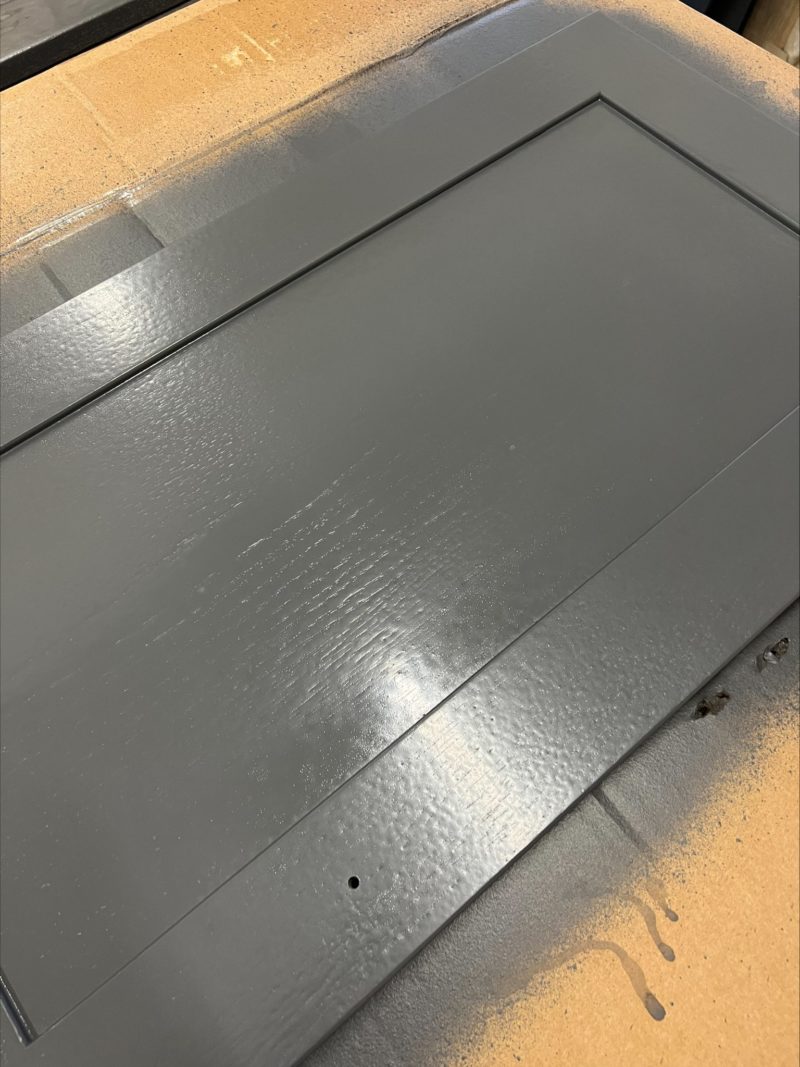
It’s not a full on professional finish but if you were to take your time, give that a rub back with wet and dry paper and lay on again, you’d be looking at about 80% quality to a professional finish – not bad for £50! Here’s a look at the cabinet re-hung:
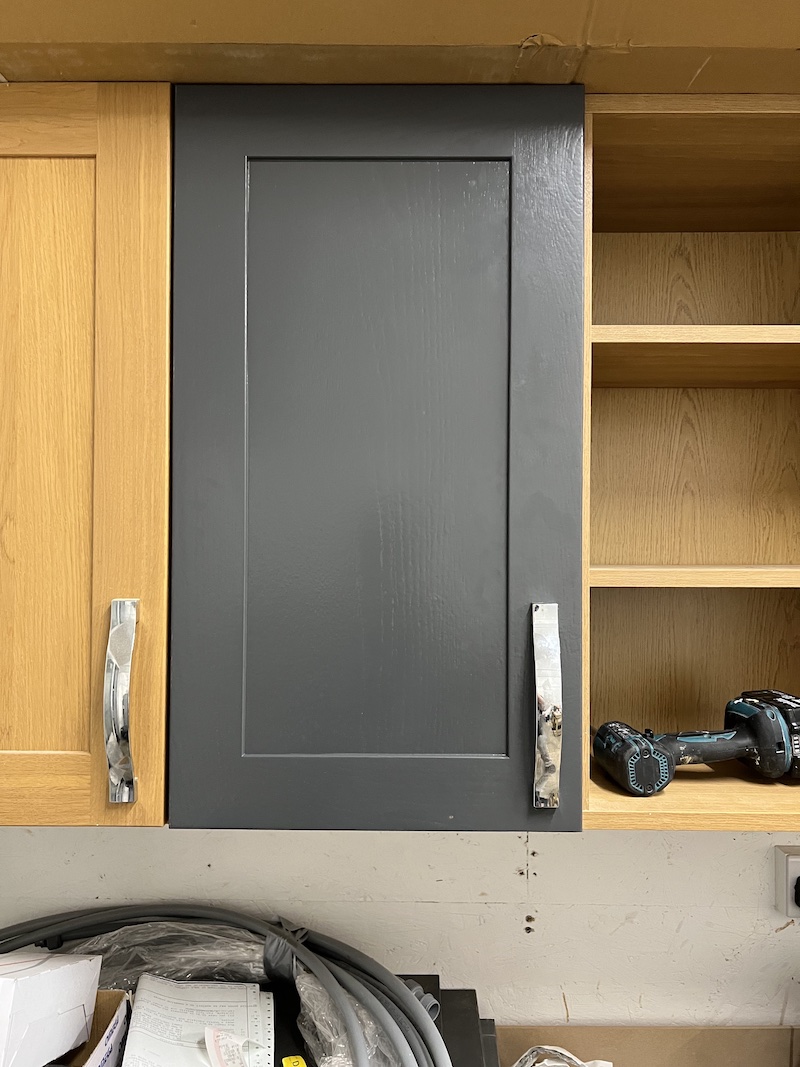
I would have no hesitation masking all of those units in my shed up, and grabbing my hop up, and then spraying the lot all in situ:
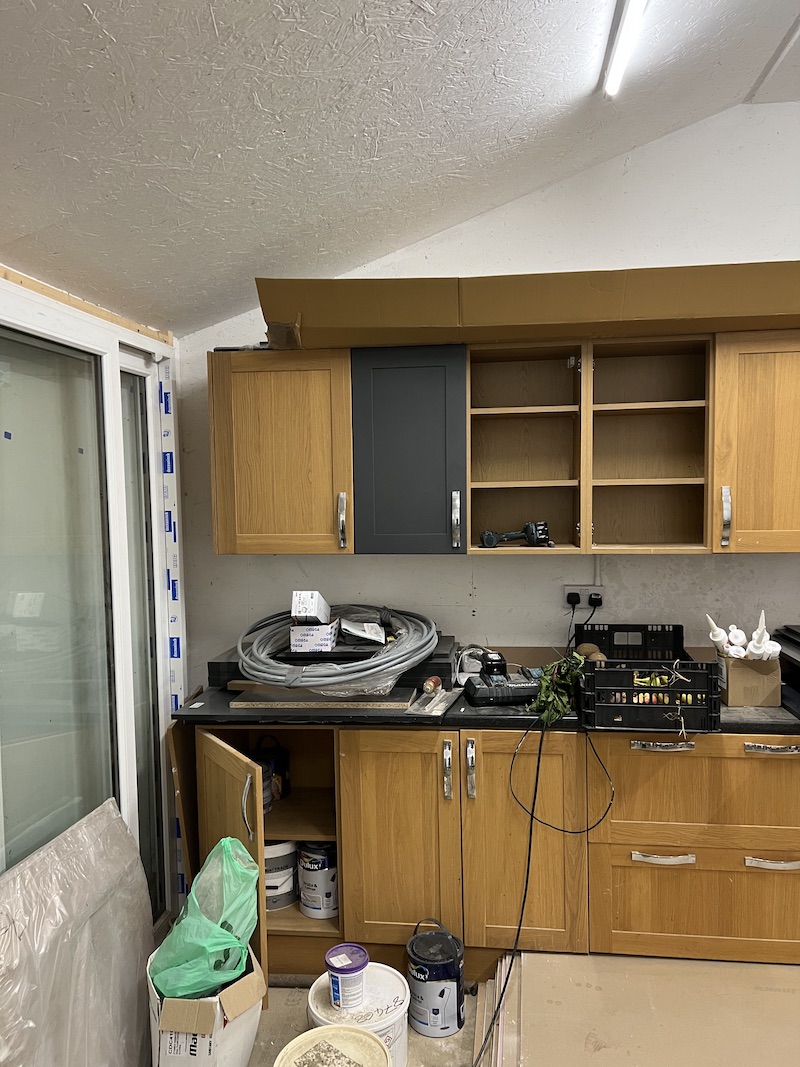
I would definitely layer the paint up slowly to avoid runs – if you want a fuller look like this then definitely take the door off to manage that – remember you are thinning the paint down – so turn up the workshop heater to full blast to cook the paint off too..
All in all I would say these cheap paint sprayers are limited when going at kitchen cabinets but fair enough finish for the money – let’s take a look at walls and ceilings.
Testing paint sprayer for walls and ceilings
In this test I pitted all four against each other. The Vonhaus, Wagner W100, Wagner fence sprayer, and the Ginour. The results were pretty much as expected and a brief overview of what happened can be found on this video:
I found the Ginour was a bit too spluttery when compared to the Wagner W100 and the Wagner had more spray coverage. The Vonhaus laid on very even coverage but was a bit on the slow side. The quickest was the Wagner fence sprayer but this was too spluttery in my opinion though here’s a look so you can decide for yourself:
Heres the Ginour – it’s a bit spluttery:
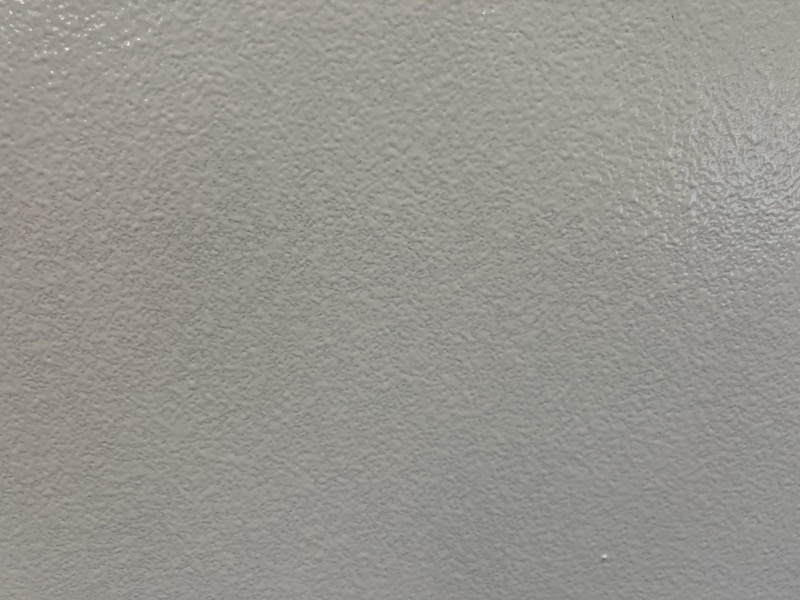
I have to say with the Ginour performing the best on the kitchen cabinets I was surprised to see it wasn’t right up there with the walls too. It was much slower flow rate than both Wagners and it also spluttered more The Wagner fence sprayer was probably too aggressive but the W100 was right on the money. The best was the Wagner W100. So let’s move onto that:
The Wagner W100 finishes nicer in my opinion. Here’s a look at that close up:

So the Wagner fence sprayer is really really quick. You can’t knock the power for the money but I did find it a bit too spluttery and the paint not quite atomised enough. Now this picture isn’t quite as zoomed in either – from a distance these all look fine but it’s always better to know what you’re buying:

It was seriously quick though, if you’re trying to knockout a house in matt that’s pretty forgiving as far as lumps and bumps are concerned then it might well be fore you. I’d check the video – you can see just how much quicker it is than the other sprayers. With all that said, the neatest was probably the Vonhaus but that’s because the slow rate will send you to sleep – I would literally say a roller is quicker so hard to pick this for a speed thing! Here’s a look at the nice finish though:

As you can see that is a lovely finish and it is really zoomed right in looking for imperfections. There’s no question it was the nicest but it came at serious cost. The (lack of) speed nearly knocked me out leaning over that long 😀 It’s also the cheapest of all the budget sprayers worth testing. I have to say if I was not in a rush all the time, and I wanted the best finish for the price, this probably wins, but I warn you it’s slow!
So with the testing out the way let’s take a look at these paint sprayers in detail:
1. Wagner W 100 Electric Paint Sprayer
As someone that uses spray systems professionally I can safely say on a budget the Wagner W 100 Electric Paint Sprayer is the best paint sprayer available in the UK. Unless you’re willing to change up to an air compressor and level up considerably this little sprayer will do you just fine. It’s the nicest looking unit of the budget sprayers too:
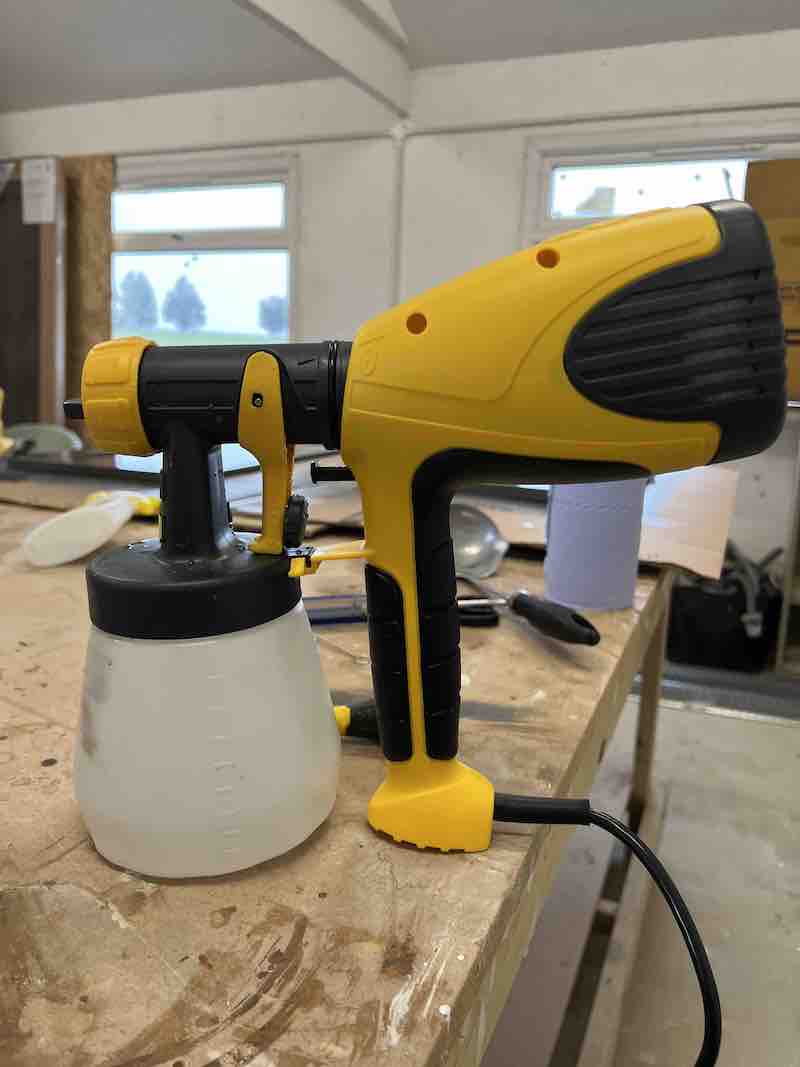
After holding all these budget sprayers in my hand and testing them, I’d have to say this one is the best balanced, and despite having a smaller pot like the Vonhaus which I thought would bug me, I actually preferred the lighter carry – it’s considerably lighter on the back than the Ginour which really is a weight when your arm stretched out. On the fence panels paint test I really did struggle with the weight of the Ginour.
Obviously when I was testing this on the ceiling the re-fill is more frequent, the obvious downside to a smaller pot, but given the choice with a bigger pot I would still be inclined to half fill it knowing what I know about my back after using the Ginour with a huge pot! The Wagner W100 offers extra comfort from less weight! I hope I’ve made that clear because it’ll be one of the key problems you face if deciding on another unit.
For ceilings and walls this does finish good enough and it’s quick. Here’s a look up close at how the paint lays on:

It’s quick and accurate, once dried looks almost as good as a professional with a roller – so in this use case we are up at professional level – seriously not bad for just £50! You can paint an entire 8 by 4 sheet of plasterboard in about three minutes and it only needs two coats if using the Matt Dulux super white – I know this from the tests.
Looking at the paint sprayer closely, the design is pretty similar to the Vonhaus but better. It attaches and engages in exactly the same way:
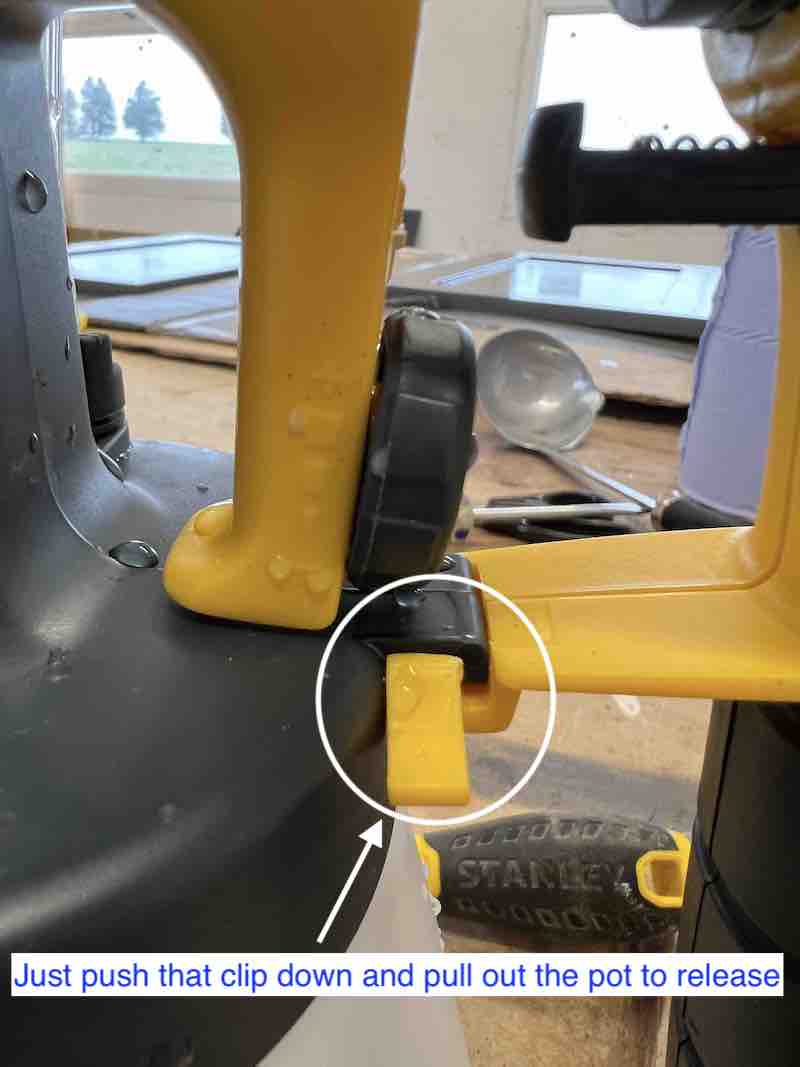
As far as a detail sprayer goes, I can’t call it that. For a start you have a fair bit of overspray (paint spitting everywhere basically). It performed well on the walls and ceilings, but for kitchen cabinets, unless you’re laying on water based and it’s flattening out nicely I would say no. Here’s a look at my tests to be sure though:
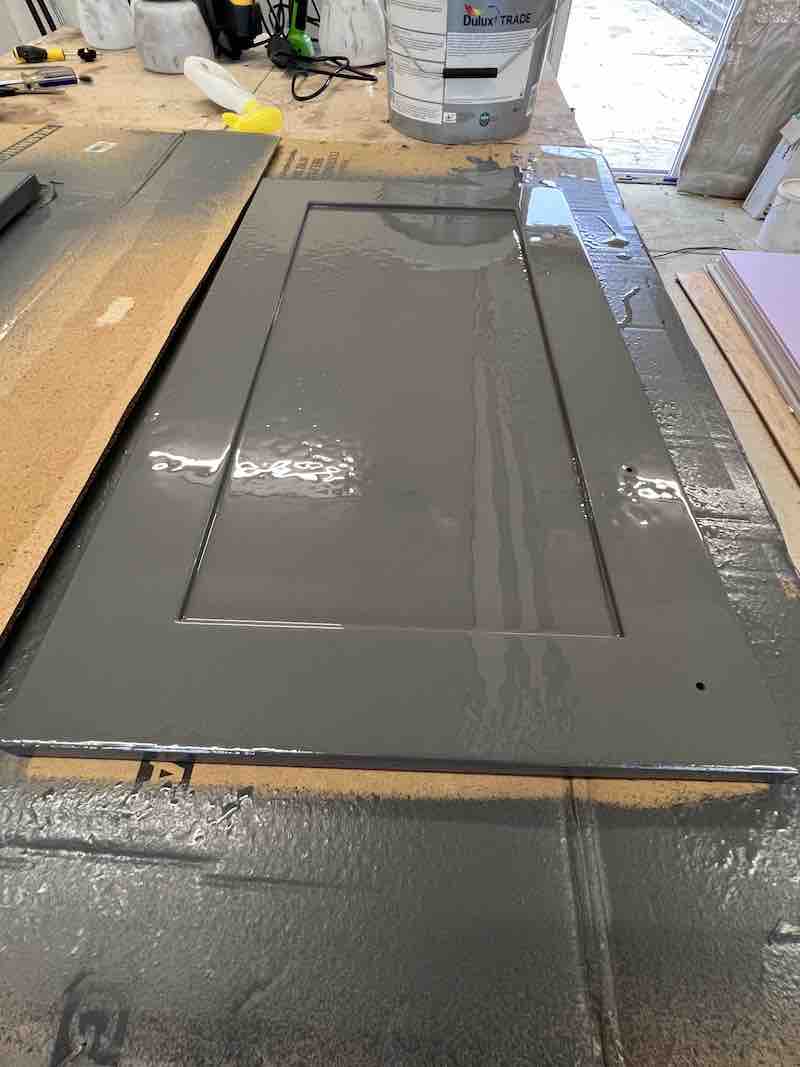
If that was sitting upright it would probably run, and therefore I would have applied less paint. When dried I was pretty pleased considering we are on a budget. Here’s a look at how it dried from my testing:
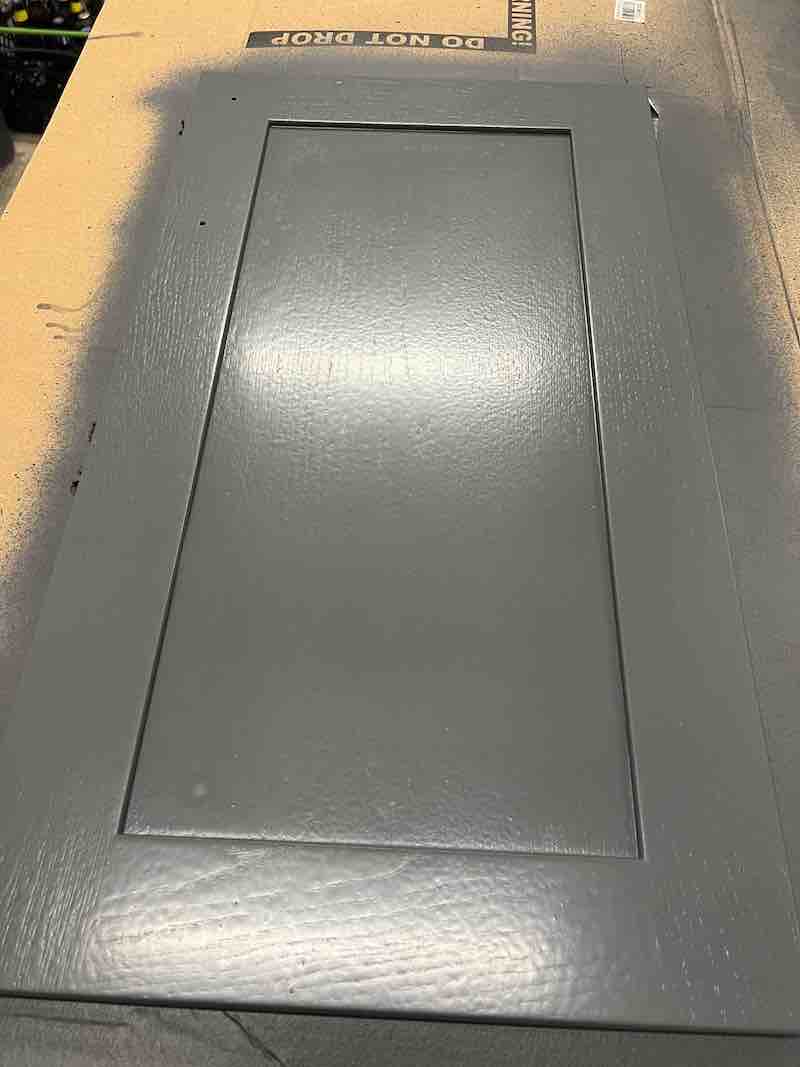
As you can see with a water based paint thinned a bit, the paint will help you out – if this was a thicker paint it would have finished like Artex 😀 Now don’t get me wrong, I might sound like I am tearing this paint sprayer to pieces – and yes I am, but within the context of the price paid it’s a great buy for mid range work, though there’s no chance of using this in a professional setup.
Now for what you would think I really don’t like – the Ginour comes with loads of different spray bores and the Wagner only comes with one. They obviously know something Ginour don’t. In testing the Wagner and Ginour (even with a smaller bore) spluttered just the same as Wagner. Basically Wagner accept the limitation of this tool without trying to overdo it. I have to say it’s sensible enough. So the bore gauge turns out not to be much of a big deal but if you check the Ginour review you’ll see overall it is a bit finer on kitchen cabinets.
Overall you can’t go wrong with this sprayer – it’ll work on walls, kitchen cabinets to an extent, easily on garden furniture, and overall is the best paint sprayer on a budget.
2. Ginour Fence Paint Sprayer
When I tested the Ginour as a fence paint sprayer it performed pretty well – it was a decent second best to the Wagner fence sprayer. As a paint sprayer it was an unlikely victor as the best sprayer for kitchen cabinets. This is in large part down to the fact it has variable spray settings from different nozzles that have different bores. Here’s a look at those:

At first glance being the only sprayer with this in the budget range you would think it puts them miles ahead. Unfortunately not. When I directly tested this against the Wagner W100 it turns out you’ll get the same splattering paint irrespective of which bore you use but for kitchen cabinets overall the paint does come out finer:

Here’s a look at how that comes out dry – not too bad at all I have to say:
And from a distance they look super – no I wouldn’t call it a professional finish, certainly nothing like we produce in a paid environment, but for a go at home I think it’s sensible enough and from a yard it looks good:

As a test panel on the first go with this gun I think it came out well. Benefitting from my experience with this sprayer I would water paint down 15% max – assuming you use a water based Dulux as I did.
In terms of setup and use this thing is so easy it’s almost plug and go. They all go together easy but none more so than this unit:
3. VonHaus Electric Paint Sprayer for Fences
The VonHaus electric paint sprayer is what I would call the lowest powered of all the paint sprayers I tested but certainly the neatest. There’s a price to paint for the neatness though, and that is speed – as a kitchen cabinet sprayer it matches the Ginour but takes much much longer to produce the same results. Here’s a look at that:
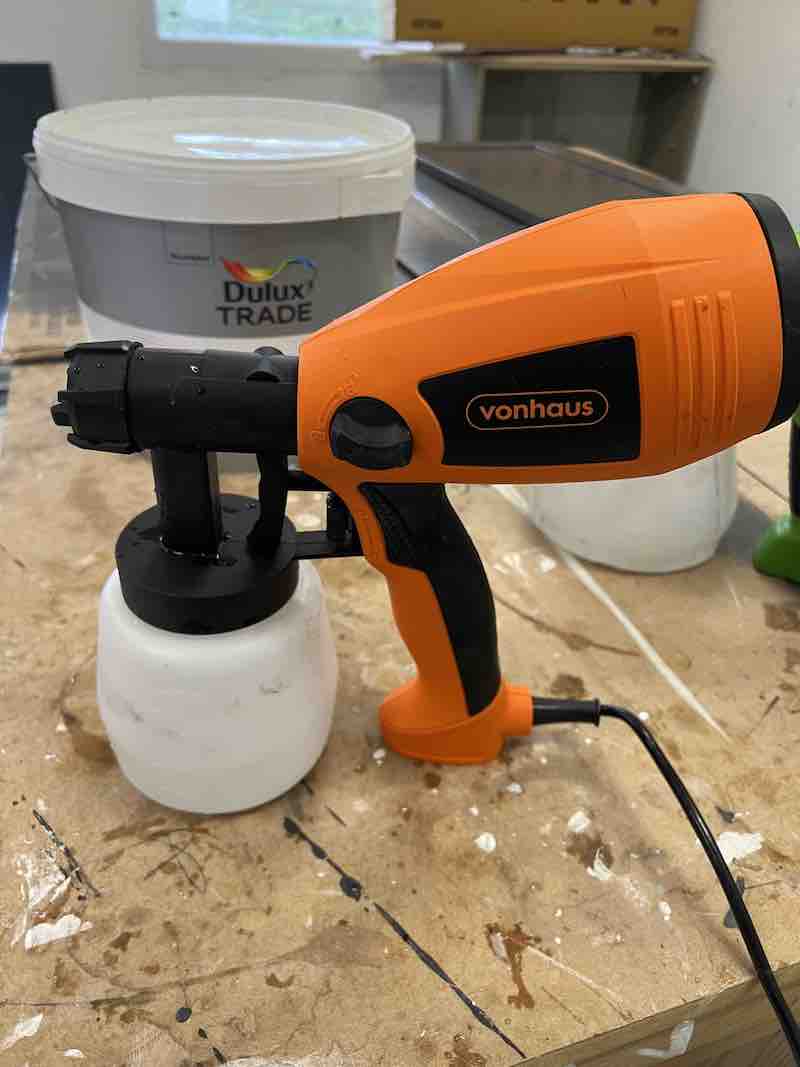
As a paint sprayer for walls and ceilings it leaves a nicer finish than the rest but takes longer than a roller! It’s hard for me to recommend this unless you want to produce the best possible result for the lowest price, and then that is where this fits in the food chain! It’s so easy to use and setup though, just push the paint pot into the turbine and go. Really that easy – removing the paint pot from turbine took me some doing though – more on that later.
Here’s a look at how this comes out on a wall:

As you can see this actually comes out very nice and is the only sprayer that matches the Wagner W 100 for atomisation of the paint – don’t read too much into those words of praise though, we aren’t talking about a perfect spray finish – it still splutters a bit though is definitely the best finish but as I say, it is very slow. Part of the reason it’s good at spraying evenly is the small spray nozzle:
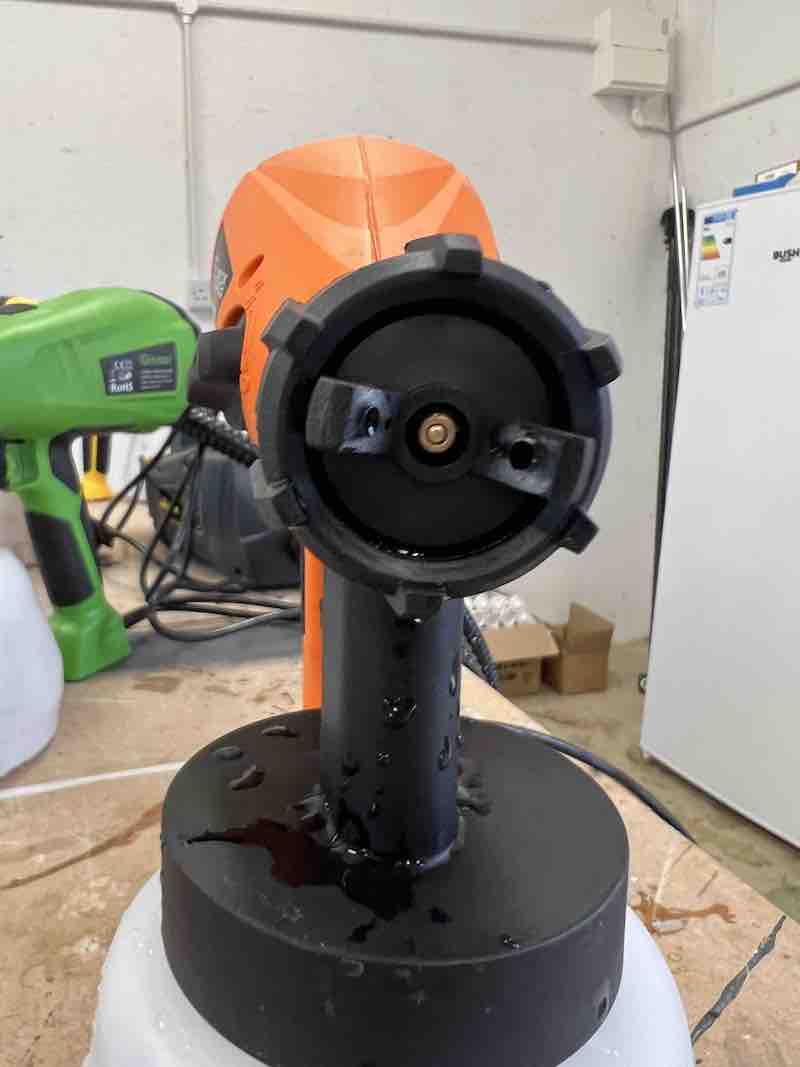
In terms of handling it’s nice, the lightweight engine and smaller paint pot gives you a decent chance of holding outward at reach without a bad back – however, as I keep going back to, this is slow so neutralises this benefit a fair bit but still the lightest of all the testing – with exception of the Wagner fence sprayer that has the separate turbine – this is the next level for comfort but I found too powerful for spraying in any sort of elegant capacity.
What’s going to thoroughly annoy you though is the attachment. Pushing it in isn’t too bad, but pulling the paint pot out the engine really takes some doing. I found a pack of vaseline in the box – that definitely improves the lubrication but still, the first time I did it without left a lasting impression with me!
Overall I would say this is a solid unit as long as you know it’s not going to be a quick solution. If you’re really trying to get work done it’ll frustrate you.
4. NoCry 1200ml/min Electric Paint Sprayer
Specification: Power: 600W, Flow: 1200 ml/min, Maximum viscosity: 100 DIN/s, Nozzle Sizes: 1.5 mm/1.8 mm/2.2 mm/2.6 mm, Container capacity: 1000 ml
In my opinion, this is one of, if not the best paint sprayer out there in its price range, combining sturdy build quality, great paint spraying performance and pretty much all the features you could possibly need when painting your walls, fence, or other surface.
Let’s start with how well the Nocry paint sprayer is put together. When held in the hand it just feels a lot more substantial than most other brands, with a thick, hard wearing plastic shell, and just enough weight (1.6kg) to give you confidence that it won’t fall apart on you while still remaining light enough to wield for a whole day.
Its performance is also excellent, and you can easily lower your work time to a fraction of what it would be if only using a roller and I did an entire fence on my own in just a couple of hours. This is thanks to the 600 watt electric motor that helps you airbrush a whole host of coating materials such as lacquer, oil, and paint, up to 100DIN/sec (viscosity) at flow rates up to 1200ml/min.
To help you check the viscosity of your chosen paint, Nocry has included a funnel flow cup with this paint sprayer and it is a very simple but handy way to know whether or not you have to water your material down before using it with the tool. Simply pour your material into the flow cup and time how long it takes to run through it. Anything less than 100 seconds and this paint sprayer will handle it.
There are also 4 different sized nozzle tips included with the Nocry paint sprayer- 1.5, 1.8, 2.2 and 2.6mm in diameter so that you can always get the right size to match the thickness of your paint. Further adjustments can be made to the material flow and air flow speed through easy to reach controls, and you can change the spray pattern from horizontal, to vertical, to circular, with a simple click of the nozzle.
Also included in the packaging are a 1000ml paint container and a cleaning pin and brush. Cleaning is actually a piece of cake with this paint sprayer as the paint container and the spray attachment itself are removable.
Coming with some of the clearest instructions I’ve seen in a while, a 4 year warranty, and the Nocry guarantee that they will replace any product that doesn’t arrive as it should, you are on to a winner with this excellent paint sprayer. Highly recommended.
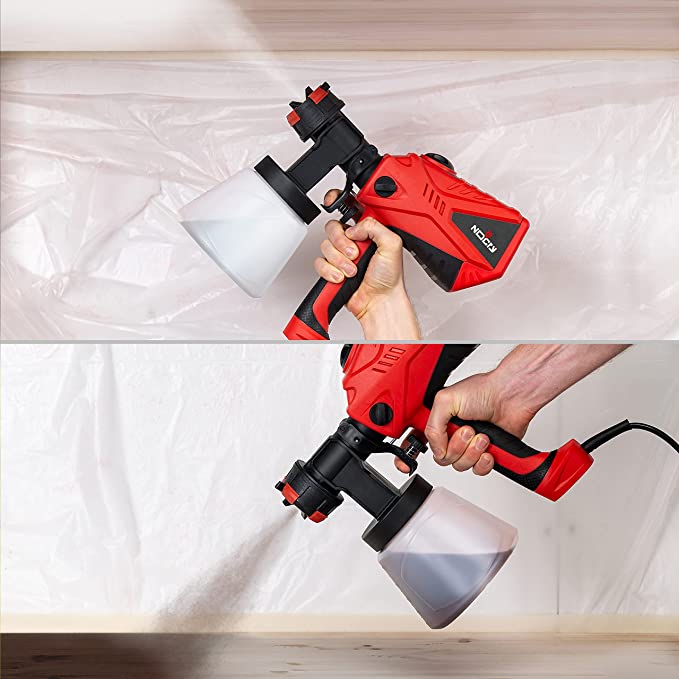
5. Tacklife Paint Sprayer, SGP15AC Electric Paint Spray Gun
Specification: Power: 400W, Flow: 800 ml/min, Maximum viscosity: 70 DIN/s, Nozzle Sizes: 2 mm/2.5 mm/3 mm, Container capacity: 900ml
Versatile and affordable are the words I think describe the Tacklife paint sprayer the best.
It doesn’t matter whether you are looking to give a wall a nice thick coating or if you are planning on tackling a job that needs a bit more precision and refinement, the Tacklife paint sprayer will see you through it.
Not only can you alter the spray pattern through 3 different settings, but also adjust the width of the overall spray. This gives you a lot of options once you start combining settings so you can cover large areas first, then just with the turn of a couple of switches you can have a spray that is perfect for finishing off the edges and hard to reach areas.
There are three nozzles that come with this Tacklife paint sprayer in 2.0mm/2.5mm/3.0mm sizes and they are also handily colour coded which makes choosing the right one in a hurry much easier. In our tests, I did find that the largest nozzle seemed to have a more focused and controlled spray than the others but that could have been through me tinkering with other settings as I got used to the paint sprayer’s controls.
Speaking of controls, the ones on this Tacklife tool are all easy to reach and simple in operation. There is an adjustable valve knob on the back of the trigger to control the flow of material, the spray pattern is changed by twisting the nozzle, and just behind that, on top of the spray attachment is a sliding switch to adjust the width of the spray.
This sprayer can be dismantled into three parts in much the same way as most products like this to make it easier to clean them and there are cleaning tools provided by Tacklife in the packaging for just that task.
The 400W electric motor actually performs much better than I expected and on maximum flow settings you can make this paint sprayer’s output reach 800ml/min. That’s crazily fast, and definitely enough to get any kind of painting job done in double quick time.
Priced 35 pounds, the Tacklife is a fair bit cheaper than Nocry’s paint sprayer and in many ways it is on par with it, however I did notice that there was a little more splash with this model when compared to the Nocry. It wasn’t anything bad per say, it’s just that the Nocry paint sprayer really impressed me in this regard and so it was hard for the Tacklife to live up to. I also put it down to Tacklife’s fast spray speed.
All said, this is a very good product for the price and does the job it sets out to do with good performance and some excellent spray control features.
6. Wagner Fence & Decking Paint Sprayer
Specification: Power: 460W, Flow: 150 ml/min, Maximum viscosity: 170 DIN/s, Nozzle Sizes: N/A, Container capacity: 1400 ml
There are more than a few things that Wagner got right with their fence and decking paint sprayer, but here are the ones that really stuck out for me.
Firstly, one of the drawbacks of using these types of paint sprayers for walls is that the paint container attachment usually has to be refilled quite often. Wagner have addressed this by making their container larger and giving it a capacity of 1400ml, around 50% extra over the Tacklife model.
The Wagner paint sprayer also has a much higher maximum viscosity at 170 Din/sec which means that you can use much thicker paint with no need to water it down and that results in a thicker coat on the surface. Of course, this means that you need to apply less coats overall and so it saves time.
With the ability to use normal fence paints and not just special spray able ones, as well as a long list of other coating materials, this Wagner paint sprayer offers you a lot of versatility when it comes to getting the colour and finish that you want. The paint flow is fully adjustable and this sprayer has the usual settings for a horizontal, vertical or circular spray pattern.
One thing some people might not like about this model is that the sprayer is attached to a turbine that also has to be carried around with you as you work. For me, it wasn’t a bother at all as it isn’t exactly heavy and you can use the shoulder strap to take most of what little weight there is anyway.
Just like our two previous reviews, this tool comes apart quickly and easily to stop cleaning being a chore and we got this sprayer fully washed up in about 5 minutes after a long session with thick paint.
One thing I will mention is that you have to keep the nozzle wet/damp to stop it clogging up with paint if left for a little while, but that applies to most paint sprayers anyway. Apart from that, my only other gripe is that I wish the power cable was a little longer but, again, that is common on power tools these days and extension leads are easy to come by.
Another excellent paint sprayer for walls, decking and fences provided by Wagner. It’s not hard to see why they have such a good reputation.
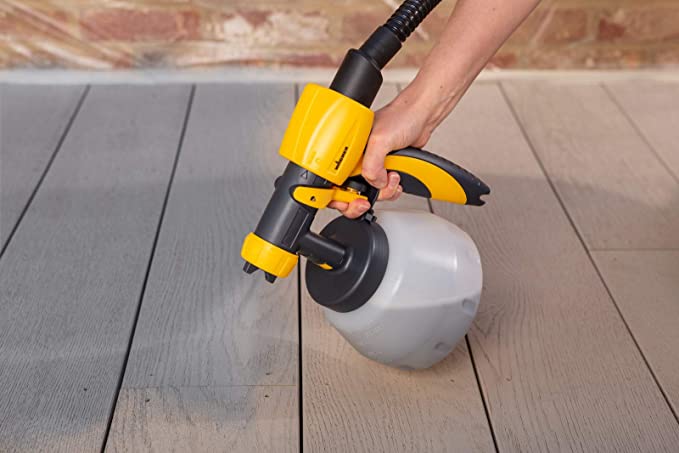
7. Terratek Paint Sprayer, 550W DIY Electric Spray Gun
Specification: Power: 550W, Flow: 130-150 ml/min, Maximum viscosity: N/A, Nozzle Sizes: N/A, Container capacity: 800 ml
One thing Terratek does well is make great looking products. Everything they design has a very modern, almost futuristic aesthetic, and this paint sprayer follows in that trend.
Measuring 26.4 x 21 x 17.4 cm and weighing 1.46kg, it is one of the most compact and lightweight of all of our reviewed products here today and would be ideal for jobs where mobility and ease of movement is a priority. It also makes it a great tool for getting in those spaces that wouldn’t be possible with a larger, bulkier paint sprayer.
Even though this is indeed a lighter tool, it certainly does not lack power and is fitted with a 550W electric motor. While this does make it a little louder than some weaker powered models, it does mean that you can get those walls nicely coated in no time at all.
This model is obviously aimed at getting first time users interested in using a paint sprayer rather than seasoned decorators. It has done away with all the extra nozzles of different sizes and some other features commonly found on these products and instead delivers a paint spraying tool that is accessible to complete beginners. The set-up, controls, and operation of this Terratek model have been made as simple and easy to use as possible.
There are some basics that this model is stuck with though, such as the 3 different spray modes and paint flow that you can tailor to your wants and needs. There is also a nice feature that automatically regulates the amount of paint that comes out so as to prevent wastage and dripping.
Build quality is much better than you would expect from something that costs around 35 pounds, with solid plastic and nice rubber covering for the handle for extra grip. The twisting action of the nozzle and smoothness of the trigger were all what they should be, but the cable felt a little stiff for me, although that could just because it was fresh out of the box and will probably loosen over time with more use.
Low cost, looks great, and easy to use. I wouldn’t say it was a world beater but definitely worth the price tag, especially if you are new to using one of these tools or you are looking for a compact paint sprayer.
8. Paint Sprayer,Meterk Electric Spray Gun
Specification: Power: 400W, Flow: 800 ml/min, Maximum viscosity: 60 DIN/s, Nozzle Sizes: 1.3mm/1.8mm/2.6mm, Container capacity: 800 ml
Meterk’s electric spray gun sits in the exact price range that the Tacklife and Terratek paint sprayers also occupy, but still manages to hold its own with traits of both of its main competitors and features of its own on top.
It resembles the Terratek in its size and weight, even surpassing it in the compactness category but still being a tiny bit heavier. This makes it great for larger jobs when you’re going to be spending a lot of hours holding your paint sprayer as the hand and arm fatigue will be less of a problem.
Like the Tacklife model, this Meterk sprayer comes with a selection of nozzles, three to be exact, in 1.3mm, 1.8mm, and 2.6mm sizes. It also has the almost obligatory twistable nozzle to select from the three main spray patterns we have mentioned several times already.
What I did like about the design of the Meterk model was the placement of the adjustable valve dial. It sits right on the back of the trigger, which is nothing new, but for some reason it just felt better placed with this model and more natural to use with the thumb.
This is a high volume low pressure paint sprayer which means that there is less wasted paint and splatter, and also that less pollution going into the air, which is great but unfortunately the Meterk has a lower viscosity maximum than the other sprayers at only 60DIN/sec which means you are limited to what types of paints you can us, or you will have to heavily water them down and this will probably lead you to having to apply more coats to get the finish you are after.
Saying that, it does have a decent 400 watt electric motor and on max settings, the flow rate is very good. I certainly didn’t think it was noticeably slower than any of the others, really.
Where the Meterk’s strength lies is in its compact design and ergonomics. It sits so nicely in the hand and has great balance, something that isn’t always easy to achieve for something priced so low. It is also very portable and also easy to clean.
So, if you want the small size of the Terratek combined with the choice of nozzles that the Tacklife sprayer offers, the Meterk spray gun might be for you.
Conclusion
Luckily, we have other options these days, and one of them is to invest in one of the best paint sprayers for walls. These machines can be bought for much less than you would think, they are usually easy to set up and operate, and will help you to get the job done in a fraction of the time, with a lot less physical effort. They can also be used to spray wood preserver or wood stain too but if you’re after fencing or specifically garden woodwork protection, I would probably look at the fence sprayer review and if you have the money, an electric fence sprayer. These things are incredible!
What’s more, you can configure these sprayers to your liking by altering the pressure or changing the nozzle.
So what traits do the best paint sprayers have in common? To find the answer to this question, plus a host of other useful information on these products, please skip to our buyer’s guide at the bottom of the page.
Or, you can read through our reviews of the paint sprayers that most DIY and gardening enthusiasts are buying in the UK to paint their walls and fences.































